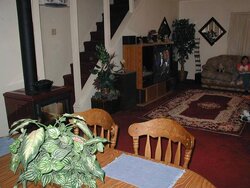Howdy everyone, happy 2007!
I've had a home design that I've been putting together for years now. In short, it's a square, will have a shed roof, be buried 3/4 into the ground on all sides except the south facing. The south facing wall will be strawbale. The other 3 walls either concrete or earthship, probably concrete. Inside will be a timberframe structure, and accomodations to easily add a 2nd floor should the need arise.
Since I've been getting into this wood burning hobby, I've had second thoughts concerning my design. But as I was thinking purely from a design aspect, I realized that I know very little about the considerations on heating a home. I've read from several of you about owning old farm houses that are designed to be heated with wood. I'm wondering, well how is it designed to be heated with wood?
I do have a few ideas, but I'm going to keep my mouth shut and wait for you folks to answer. Thanks.
-Kevin
I've had a home design that I've been putting together for years now. In short, it's a square, will have a shed roof, be buried 3/4 into the ground on all sides except the south facing. The south facing wall will be strawbale. The other 3 walls either concrete or earthship, probably concrete. Inside will be a timberframe structure, and accomodations to easily add a 2nd floor should the need arise.
Since I've been getting into this wood burning hobby, I've had second thoughts concerning my design. But as I was thinking purely from a design aspect, I realized that I know very little about the considerations on heating a home. I've read from several of you about owning old farm houses that are designed to be heated with wood. I'm wondering, well how is it designed to be heated with wood?
I do have a few ideas, but I'm going to keep my mouth shut and wait for you folks to answer. Thanks.
-Kevin



